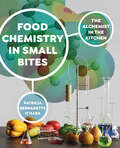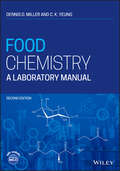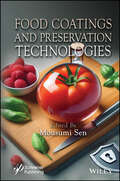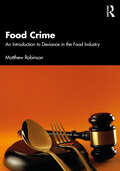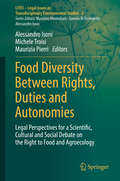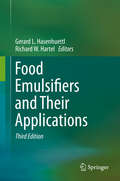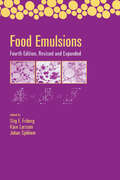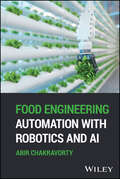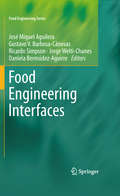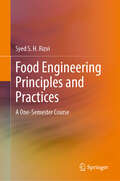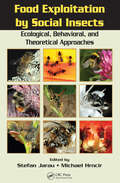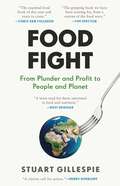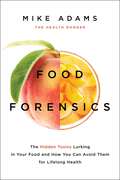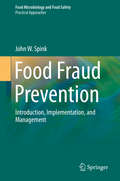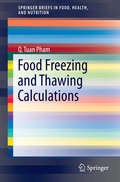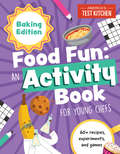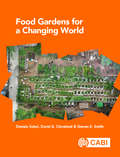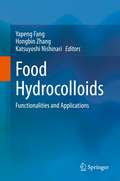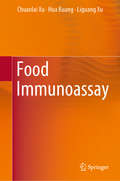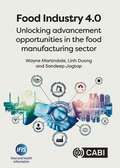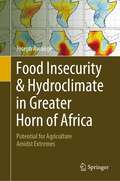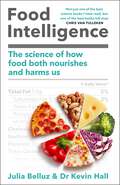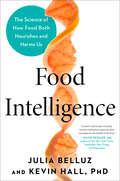- Table View
- List View
Food Chemistry in Small Bites: The Alchemist in the Kitchen
by Patricia B O'HaraFood Chemistry in Small Bites takes readers on an up-close scientific journey through the transformation of food when meals are prepared. Organized in bite-size, digestible units, this innovative text introduces students to food's molecular makeup as well as the perception of food by the five senses. Using familiar foods as examples, it explores what happens to ingredients when heated, cooled, or treated and also considers what happens when materials that don’t naturally mix are forced to do so. With informative, full-color renderings and a hands-on lab section, the book encourages students to think like scientists while preparing delicious dishes. Readers will formulate hypotheses as to why certain foods taste hot despite being at room temperature, why milk separates into curds and whey when lemon is added, and other ordinary but chemically complex phenomena. This book also importantly challenges readers to think critically about the future of food in the face of a warming planet.
Food Chemistry: A Laboratory Manual
by Dennis D. Miller C. K. YeungFOOD CHEMISTRY A manual designed for Food Chemistry Laboratory courses that meet Institute of Food Technologists undergraduate education standards for degrees in Food Science In the newly revised second edition of Food Chemistry: A Laboratory Manual, two professors with a combined 50 years of experience teaching food chemistry and dairy chemistry laboratory courses deliver an in-depth exploration of the fundamental chemical principles that govern the relationships between the composition of foods and food ingredients and their functional, nutritional, and sensory properties. Readers will discover practical laboratory exercises, methods, and techniques that are commonly employed in food chemistry research and food product development. Every chapter offers introductory summaries of key methodological concepts and interpretations of the results obtained from food experiments. The book provides a supplementary online Instructor’s Guide useful for adopting professors that includes a Solutions Manual and Preparation Manual for laboratory sessions. The latest edition presents additional experiments, updated background material and references, expanded end-of-chapter problem sets, expanded use of chemical structures, and: A thorough emphasis on practical food chemistry problems encountered in food processing, storage, transportation, and preparation Comprehensive explorations of complex interactions between food components beyond simply measuring concentrations Additional experiments, references, and chemical structures Numerous laboratory exercises sufficient for a one-semester course Perfect for students of food science and technology, Food Chemistry: A Laboratory Manual will also earn a place in the libraries of food chemists, food product developers, analytical chemists, lab technicians, food safety and processing professionals, and food engineers.
Food Coatings and Preservation Technologies
by Mousumi SenThis book compiles recent studies about edible coatings and how they have improved food products, packaging techniques, and product quality to cause fewer health risks. Food Coatings and Preservation Technologies presents the most recent studies about the application of edible coatings to a wide variety of foods. Edible coatings are globally utilized for preventing food product contamination from harmful microorganisms and pathogens. This book highlights the developments made in designing new edible coatings. Herein, particular attention is given to the main components, manufacturing methods, and their application to specific products. The book also discusses the current state-of-the-art alternative to conventional package usage, providing the main features biodegradable packaging should meet for distinct uses for the conservation and improvement of various food products. This information will be helpful for processors to select the best coating material and its effective concentration for different fresh and minimal processed vegetables. Each chapter delves into edible-based coating research and critical developments to enhance food preservation standards. The first section focuses on biopolymer-based edible coatings, food packaging, and preservation. It provides a comprehensive understanding of the current state and critical developments in biodegradable polymer packaging systems for food applications. As technology advances, the next section highlights ongoing research focusing on optimizing coating effectiveness and the development of eco-friendly and sustainable materials. This section’s objective is to identify edible materials and combine the most recent information available to provide a comprehensive understanding of formulation methods and approaches to enhancing the properties of the coatings applied to food products. The final section discusses encapsulation techniques and levels of retention to improve shelf-life. Readers will find in this book information concerning: The efficiency and functional properties of edible coating materials; Feasibility studies performed on new process evaluation, safety and toxicity determination, regulatory assessment, and consumer studies regarding the commercial uses of edible coatings; Coating technologies that present a promising avenue to enhance the delivery, stability, and efficacy of medical foods and nutraceuticals; Shelf-life testing that suggests future directions; Novel practical and reliable tools that are applicable in the industrial process. Audience The book is aimed at chemists, food technologists, food scientists, nutritionists, dietitians, pharmaceutical technologists, biochemists, and engineers, as well as postgraduate, PhD students and postdocs working in the area of edible food coatings and prevention technologies.
Food Crime: An Introduction to Deviance in the Food Industry
by Matthew RobinsonThis book addresses the various forms of deviance and criminality found within the conventional food system. This system—made up of numerous producers, processors, distributors, and retailers of food—has significant, far-reaching consequences bearing upon the environment and society.Food Crime broadly outlines the processes and impacts of this food system most relevant for the academic discipline of criminology, with a focus on the negative health outcomes of the US diet (e.g., obesity and diabetes) and negative outcomes associated with the system itself (e.g., environmental degradation). The author introduces the concept of "food criminology," a new branch of criminology dedicated to the study of deviance in the food industry. Demonstrating the deviance and criminality involved in many parts of the conventional food system, this book is the first to provide exhaustive coverage of the major issues related to what can be considered food crime. Embedded in the context of state-corporate criminality, the concepts and practices exposed in this book bring attention to harms associated with the conventional food system and illustrate the degree of culpability of food companies and government agencies for these harms.This book is of interest to students, scholars, and practitioners seeking a more just and healthy food system and encourages further future research into food crimes in the disciplines of criminology, criminal justice, and sociology.
Food Diversity Between Rights, Duties and Autonomies: Legal Perspectives For A Scientific, Cultural And Social Debate On The Right To Food And Agroecology (Lites - Legal Issues In Transdisciplinary Environmental Studies #2)
by Alessandro Isoni Michele Troisi Maurizia PierriThe book reflects on the issues concerning, on the one hand, the difficulty in feeding an ever- increasing world population and, on the other hand, the need to build new productive systems able to protect the planet from overexploitation. The concept of “food diversity” is a synthesis of diversities: biodiversity of ecological sources of food supply; socio-territorial diversity; and cultural diversity of food traditions. In keeping with this transdisciplinary perspective, the book collects a large number of contributions that examine, firstly the relationships between agrobiodiversity, rural sustainable systems and food diversity; and secondly, the issues concerning typicality (food specialties/food identities), rural development and territorial communities. Lastly, it explores legal questions concerning the regulations aiming to protect both the food diversity and the right to food, in the light of the political, economic and social implications related to the problem of feeding the world population, while at the same time respecting local communities’ rights, especially in the developing countries. The book collects the works of legal scholars, agroecologists, historians and sociologists from around the globe.
Food Emulsifiers and Their Applications
by Richard W. Hartel Gerard L. HasenhuettlEmulsifiers, also known as surfactants, are often added to processed foods to improve stability, texture, or shelf life. These additives are regulated by national agencies, such as the FDA, or multi-national authorities, such as the EEC or WHO. The amphiphilic molecules function by assisting the dispersion of mutually insoluble phases and stabilizing the resulting colloids, emulsions, and foams. Emulsifiers can interact with other food components such as carbohydrates, proteins, water, and ions to produce complexes and mesophases. These interactions may enhance or disrupt structures and affect functional properties of finished foods. In dairy processing, small molecule emulsifiers may displace dairy proteins from oil/water and air/water interfaces, which affects stability and properties of the foams and emulsions. In baked products, emulsifiers contribute to secondary functionalities, such as dough strengthening and anti-staling. Synthetic food emulsifiers suffer from the stigma of chemical names on a product’s ingredient statement. Modern consumers are seeking products that are “all natural.” Fortunately, there are a number of natural ingredients that are surface-active, such as lecithin, milk proteins, and some protein-containing hydrocolloids. Mayonnaise, for example, is stabilized by egg yolk. This book can serve as both a guide for professionals in the food industry to provide an understanding of emulsifier functionality, and a stimulus for further innovation. Students of food science will find this to be a valuable resource.
Food Emulsions (Food Science and Technology)
by Johan Sjöblom Stig E. Friberg Kåre LarssonUpholding the standards that made previous editions so popular, this reference focuses on current strategies to analyze the functionality and performance of food emulsions and explores recent developments in emulsion science that have advanced food research and development. Written by leading specialists in the field, the Fourth Edition probes the latest technologies in food emulsion assessment for excellence in food product design and focuses on methods of emulsion characterization and investigation. It contains new discussions on droplet analysis, surface forces, and the rheology of emulsions and examines essential components of everyday foods such as breads, condiments, margarine, and cheese.
Food Engineering Automation with Robotics and AI
by Abir ChakravortyRevolutionize food manufacturing with the latest in automating technology Virtually every area of industry has been transformed by robotics and AI, which have automated production and increased efficiency in myriad ways. Until recently, food manufacturing was an exception to the trend. At present, however, the food manufacturing industry is in the process of a transformation which will see automation deliver the same levels of productivity and uniformity that have revolutionized other sectors of the economy. Food Engineering Automation with Robotics and AI is a comprehensive introduction to the areas of intersection between cutting-edge technologies and food manufacturing. Beginning with an overview of the basic principles of food engineering, the book then details applications of robotics and AI in this field, along with the way automation is integrated at every stage of food production. The structure of the book seamlessly blends theory and practice to maximize reader capacity to put its lessons into motion. Food Engineering Automation with Robotics and AI readers will also find: Content aligning with several UN Sustainable Development Goals, including Zero Hunger; Industry, Innovation, and Infrastructure; and Responsible Consumption and ProductionReal-world case studies throughout to show automating technologies revolutionizing food productionA consistent focus on sustainable food engineering, with attention to resource conservation, waste reduction, environmental impact mitigation, and more Food Engineering Automation with Robotics and AI is ideal for the growing, global market for food automation technologies in the coming years.
Food Engineering Interfaces
by Gustavo Barbosa-Canovas Daniela Bermudez Aguirre Jorge Welti-Chanes José Miguel Aguilera Ricardo SimpsonThe International Conference on Food Engineering is held every four years and draws global participation. ICEF 10 will be held in April 2008 in Chile with the theme of food engineering at interfaces. This will not be a typical proceedings with uneven contributions. Papers will be solicited from each plenary speaker plus two or three invited speakers from each topic and the goal is to publish a book that conveys the interdisciplinary spirit of the meeting as well as covers the topics in depth, creating a strong reference work. The idea is to explore how food engineers have to be prepared in years ahead not only to perform in their normal activities but also to engage in new challenges and opportunities that will make the profession more attractive, responsive, and able to create a larger impact. These challenges and opportunities are within the profession and at interfaces with other areas. A major role of engineers is to incorporate new knowledge into the profession and respond to practical needs. The goal is to explore how food engineers are integrating developments in the basic sciences of physics and chemistry, nutrition, informatics, material sciences, genomics (and other -omics), quality and safety, consumer behavior and gastronomy. Interfaces with the environment, the business sector, regulations and export markets are also important to consider.
Food Engineering Principles and Practices: A One-Semester Course
by Syed S. RizviThis textbook is designed for a one-semester course on Food Engineering, and it offers a concise, in-depth and integrated introduction to the fundamental engineering and physicochemical principles and practices of utility in food processing and manufacturing operations. The textbook includes topics mandated by the Institute of Food Technologists for accreditation of Food Science curricula and helps prepare the students better for taking advance courses related to unit operations in food manufacturing. It is also relevant for Food Process Engineering courses, containing materials that most instructors can cover in three semester hours of instruction. In the first three chapters, readers will find an overview of the basic knowledge of physics and chemistry and an introduction to the engineering language needed to eliminate confusion going forward. In the following chapters, the author covers the main concepts of food thermodynamics, heat transfer–radiation in foodmaterials, mass transfer and fluid dynamics in food, along with real-life examples and exercises to help students relate better to the topics. The author also gives a brief introduction to the main mathematical and analytical concepts required in food engineering.This textbook equips readers to understand a diversity of food engineering related topics and each chapter is enriched with practical examples and Check Your Understanding sections, as well as several problems. The textbook is aimed at undergraduate food science students in their first required introductory food engineering course, but practitioners involved in designing, optimizing, and managing the processing of food products will also find it a useful account.
Food Exploitation By Social Insects: Ecological, Behavioral, and Theoretical Approaches
by Stefan Jarau Michael HrncirOmnipresent in virtually all terrestrial ecosystems and of undisputed ecological and economical importance, the study of social insects is an area that continues to attract a vast number of researchers. As a consequence, a huge amount of information about their biology and ecology has accumulated. Distilling this scattered information into a highly
Food Fight: From Plunder and Profit to People and Planet
by Stuart Gillespie"Scholarly, literate and deeply moving, this isn't just a good read, it's an essential reference for anyone hoping to understand the food system, why it's broken and how we might imagine fixing it."—Chris Van Tulleken, author of Ultra-Processed PeopleFood is life but our food system is killing us. Designed in a different century for a different purpose—to mass-produce cheap calories to prevent famine—it&’s now generating obesity, ill-health and premature death. We need to transform it, into one that is capable of nourishing all eight billion of us and the planet we live on. In Food Fight, Stuart Gillespie reveals how the food system we once relied upon for global nutrition has warped into the very thing making us sick. From its origins in colonial plunder, through the last few decades of neoliberalism, the system now lies in the tight grip of a handful of powerful transnationals whose playbook is geared to profit at any cost. Both unflinching exposé and revolutionary call to arms, Food Fight shines a light inside the black box of politics and power and, crucially, maps a way towards a new system that gives us hope for a future of global health and justice.
Food Forensics: The Hidden Toxins Lurking in Your Food and How You Can Avoid Them for Lifelong Health
by Mike AdamsWhat's really in your food? Award-winning investigative journalist and clean food activist Mike Adams, the "Health Ranger," is founder and editor of Natural News, one of the top health news websites in the world, reaching millions of readers each month. Now, in Food Forensics, Adams meticulously tests groceries, fast foods, dietary supplements, spices, and protein powders for heavy metals and toxic elements that could be jeopardizing your health. To conduct this extensive research, Adams built a state-of-the-art laboratory with cutting-edge scientific instruments. Publishing results of metal concentrations for more than 800 different foods, Food Forensics is doing the job the FDA refuses to do: testing off-the-shelf foods and sharing the findings so the public can make informed decisions about what they consume or avoid. In Food Forensics, you'll discover little-known truths about other toxic food ingredients such as polysorbate 80, MSG, sodium nitrite, pesticides, and weed killers such as glyphosate. Adams reveals stunning, never-before-reported details of heavy metals found in recycled human waste used on crops and in parks, and he explains how industrial pollution causes mercury, lead, and cadmium to end up in your favorite protein powders. This book will forever change your view of food safety, regulation, and manufacturing. When you know what's really in your food, you can start making changes to protect yourself against serious diseases like cancer, all while maximizing your natural immune defenses against infection and disease.
Food Fraud Prevention: Introduction, Implementation, and Management (Food Microbiology and Food Safety)
by John W. SpinkThis textbook provides both the theoretical and concrete foundations needed to fully develop, implement, and manage a Food Fraud Prevention Strategy. The scope of focus includes all types of fraud (from adulterant-substances to stolen goods to counterfeits) and all types of products (from ingredients through to finished goods at retail). There are now broad, harmonized, and thorough regulatory and standard certification requirements for the food manufacturers, suppliers, and retailers. These requirements create a need for a more focused and systematic approach to understanding the root cause, conducting vulnerability assessments, and organizing and implementing a Food Fraud Prevention Strategy. A major step in the harmonizing and sharing of best practices was the 2018 industry-wide standards and certification requirements in the Global Food Safety Initiative (GFSI) endorsed Food Safety Management Systems (e.g., BRC, FSSC, IFS, & SQF). Addressing food fraud is now NOT optional – requirements include implementing a Food Fraud Vulnerability Assessment and a Food Fraud Prevention Strategy for all types of fraud and for all products. The overall prevention strategy presented in this book begins with the basic requirements and expands through the criminology root cause analysis to the final resource-allocation decision-making based on the COSO principle of Enterprise Risk Management/ ERM. The focus on the root cause expands from detection and catching bad guys to the application of foundational criminology concepts that reduce the overall vulnerability. The concepts are integrated into a fully integrated and inter-connected management system that utilizes the Food Fraud Prevention Cycle (FFPC) that starts with a pre-filter or Food Fraud Initial Screening (FFIS). This is a comprehensive and all-encompassing textbook that takes an interdisciplinary approach to the most basic and most challenging questions of how to start, what to do, how much is enough, and how to measure success.
Food Freezing and Thawing Calculations
by Q. Tuan PhamFreezing time and freezing heat load are the two most important factors determining the economics of food freezers. This Brief will review and describe the principal methods available for their calculation. The methods can be classified into analytical methods, which rely on making physical simplifications to be able to derive exact solutions; empirical methods, which use regression techniques to derive simplified equations from experimental data or numerical calculations and numerical methods, which use computational techniques such as finite elements analysis to solve the complete set of equations describing the physical process. The Brief will evaluate the methods against experimental data and develop guidelines on the choice of method. Whatever technique is used, the accuracy of the results depends crucially on the input parameters such as the heat transfer coefficient and the product's thermal properties In addition, the estimation methods and data for these parameters will be reviewed and their impacts on the calculations will be evaluated. Freezing is often accompanied by mass transfer (moisture loss, solute absorption), super cooling and nucleation and may take place under high pressure conditions; therefore methods to take these phenomena into account will also be reviewed.
Food Fun An Activity Book for Young Chefs: Baking Edition: 60+ recipes, experiments, and games (Young Chefs Series)
by America's Test Kitchen KidsFrom the creators of the #1 New York Times Bestseller The Complete Cookbook for Young Chefs, comes the second in a series of interactive workbooks for kids ages 8 to 12 who want recipes, science experiments, hands-on activities, and games--all about baking! Use the kitchen as your classroom, no school involved!Does salt make sweet treats taste even sweeter? Why do you have to let pizza dough rest before shaping it? Can you tell the difference between cookies baked with white sugar and cookies baked with brown sugar? Plus easy, kid-tested and kid-approved recipes for spiced applesauce muffins, almost no-knead bread, cake pan pizza, blondies, and more, Kitchen Explorers! Baking Edition brings the kitchen alive with fun baking-centric science experiments and art projects (edible and otherwise). Puzzles, word games, coloring pages and beyond will keep kids occupied and engaged.
Food Gardens for a Changing World
by David A. Cleveland Daniela Soleri Steven E. SmithFood gardening is becoming increasingly popular, as people look for new ways to live more sustainably and minimize harm to the environment. This book addresses the 21st century trends which bring new challenges to food gardening - anthropogenic climate change, environmental degradation, natural resource scarcity, and social inequity - and explains the basic biological, ecological and social concepts needed to understand and respond to them. Examples throughout the text demonstrate how to successfully use these concepts, while supporting gardeners' values, and their goals for themselves, their communities and the world.
Food Gardens for a Changing World
by David A. Cleveland Daniela Soleri Steven E. SmithFood gardening is becoming increasingly popular, as people look for new ways to live more sustainably and minimize harm to the environment. This book addresses the most pressing challenges facing food gardening in the 21st century - worldwide changes in climate, the environment, natural resources, and communities - and the basic biological, ecological and social concepts which influence our understanding. Examples throughout the text demonstrate how gardeners can use these theories to their advantage.
Food Hydrocolloids: Functionalities and Applications
by Katsuyoshi Nishinari Yapeng Fang Hongbin ZhangThe book introduces the definition, classification, source and structure of hydrocolloids and provides a comprehensive description of their functionalities and food-related applications. The emphasis is put on the basic concepts and mechanisms underlying functionalities, and the new developments in fundamental knowledge and practice. The book would be useful for students or professionals working in the fields of food science & technology, and biopolymers etc. It would help to organize hydrocolloids knowledge in a more systematic framework and enlighten further profound investigations.
Food Immunoassay
by Chuanlai Xu Hua Kuang Liguang XuThis book systematically covers immunoassays for food, presenting detailed approaches such as antigen design, food matrix pre-treatment and detection format optimization for 9 classes of food hazards and nutrition constituents. Offering ideas on how to improve the efficiency of recognized xenobiotics and food contents, this practical book also describes the discovery and utilization of novel immune agents like aptamer and molecular imprinted polymers in food analysis. It is intended for a broad range of areas, including biologists and food chemists, and is sure to become a key reference resource for students and professionals alike.
Food Industry 4.0: Unlocking Advancement Opportunities in the Food Manufacturing Sector
by Dr Wayne Martindale Dr Linh Duong Dr Sandeep JagtapThis book provides industry insights and fresh ideas for the advancement of the most vital global industry - food. Drawing on their industry and academic expertise the authors have identified three controlling aspects of food business operations that can unleash long term success: consumer health and wellbeing; product and process sustainability; and harnessing advances in digitalization.. If developed to their maximum potential these factors have the capability to revolutionize the food sector. Food Industry 4.0 highlights advancement opportunities for the food manufacturing sector, including innovation in products, processes and services, as it seeks to combine productive, efficient and sustainable practices. The contents address: Mapping data, new approaches for food system applications. The perfect meal and making a balanced global diet possible. Industry 4.0 applications in the food sector: robotics and automation, big data, Internet of Things, cybersecurity. Resource utilization in the food manufacturing sector. Resilience and sustainability in food supply chains. Environmental and social governance in our food system. It is of significant benefit to food industry practitioners working in operational and product development roles, academic researchers, policy makers, students, and food sector professionals.
Food Insecurity & Hydroclimate in Greater Horn of Africa: Potential for Agriculture Amidst Extremes
by Joseph AwangeThis book will benefit users in food security, agriculture, water management, and environmental sectors. It provides the first comprehensive analysis of Greater Horn of Africa (GHA)’s food insecurity and hydroclimate using the state-of-the-art Gravity Recovery and Climate Experiment (GRACE) and its Follow-on (GRACE-FO)’s, centennial precipitation, hydrological models’ and reanalysis’ products. It is here opined that GHA is endowed with freshwater (surface and groundwater) being home to the world's second largest freshwater body (Lake Victoria) and the greatest continental water towers (Ethiopian Highlands) that if properly tapped in a sustainable way, will support its irrigated agriculture as well as pastoralism. First, however, the obsolete Nile treaties that hamper the use of Lake Victoria (White Nile) and Ethiopian Highland (Blue Nile) have to be unlocked. Moreover, GHA is bedevilled by poor governance and the ``donor-assistance” syndrome; and in 2020-2021 faced the so-called ``triple threats’’ of desert locust infestation, climate variability/change impacts and COVID-19 pandemic. Besides, climate extremes influence its meagre waters leading to perennial food insecurity. Coupled with frequent regional and local conflicts, high population growth rate, low crop yield, invasion of migratory pests, contagious human and livestock diseases (such as HIV/AIDs, COVID-19 & Rift Valley fever) and poverty, life for more than 310 million of its inhabitants simply becomes unbearable. Alarming also is the fact that drought-like humanitarian crises are increasing in GHA despite recent progress in its monitoring and prediction efforts. Notwithstanding these efforts, there remain challenges stemming from uncertainty in its prediction, and the inflexibility and limited buffering capacity of the recurrent impacted systems. To achieve greater food security, therefore, in addition to boosting GHA's agricultural output, UN Office for the Coordination of Humanitarian Affairs suggest that its “inhabitants must create more diverse and stable means of livelihood to insulate themselves and their households from external shocks”. This is a task that they acknowledge will not be easy as the path ahead is “strewn with obstacles namely; natural hazards and armed conflicts”. Understanding GHA’s food insecurity and its hydroclimate as presented in this book is a good starting point towards managing the impacts of the natural hazards on the one hand while understanding the impacts associated with extreme climate on GHA's available water and assessing the potential of its surface and groundwater to support its irrigated agriculture and pastoralism would be the first step towards “coping with drought” on the other hand.The book represents a significant effort by Prof Awange in trying to offer a comprehensive overview of the hydroclimate in the Greater Horn of Africa (GHA). Prof Eric F. Wood, NAE (USA); FRSC (Canada); Foreign member, ATSE (Australia).
Food Intelligence: The Science of How Food Both Nourishes and Harms Us
by Julia Belluz Kevin Hall, PhD'This is not just one of the best science books I have read, but one of the best books full stop' - Chris van Tulleken, author of the Sunday Times bestseller ULTRA-PROCESSED PEOPLE'Junk-food giants hijack your biology. Wellness hucksters sell you false hope. In a food environment rigged against you, this is your guide to fighting back.' Henry Dimbleby, author of the Sunday Times bestseller RAVENOUS, and architect of the UK's National Food Strategy.'A must-read . . . written with great expertise' - David Kessler, author of the New York Times bestseller DIET, DRUGS, AND DOPAMINE'If you are going to read one book about nutrition and health, then make it this one' - Deborah Blum, Pulitzer-Prize winning author of THE POISON SQUADNutrition isn't rocket science; it's harder.There are new diet fads, bold claims about superfoods and articles promising the secrets to lasting weight-loss and longevity. The more 'expert' advice we hear about diet, the less clarity we have about what to eat.In Food Intelligence, award-winning health journalist, Julia Belluz, and internationally renowned nutrition and metabolism scientist, Kevin Hall, cut through the myths about nutrition to deliver a comprehensive book on food, diet, metabolism and healthy eating.Breaking food down into its constituent parts, they reveal the science behind how protein, fat, carbs and vitamins impact our bodies. They shine a light on the wonders of metabolism, and debunk the latest 'theories' about blood sugar trackers and ultra-processed foods. They reveal the ways that the world around us - our food environment - shapes our eating behaviours and the food choices we make every day. Diseases like obesity and type 2 diabetes are not a result of a failure of will power; they are consequences of food systems working as designed. Humane and deeply reported, this journey into the science of what we eat will equip you with the food intelligence you need to better understand what's on your dinner plate, how it got there, and why you eat it.
Food Intelligence: The Science of How Food Both Nourishes and Harms Us
by Julia Belluz Kevin Hall, PhD'This is not just one of the best science books I have read, but one of the best books full stop' - Chris van Tulleken, author of the Sunday Times bestseller ULTRA-PROCESSED PEOPLE'Junk-food giants hijack your biology. Wellness hucksters sell you false hope. In a food environment rigged against you, this is your guide to fighting back.' Henry Dimbleby, author of the Sunday Times bestseller RAVENOUS, and architect of the UK's National Food Strategy.'A must-read . . . written with great expertise' - David Kessler, author of the New York Times bestseller DIET, DRUGS, AND DOPAMINE'If you are going to read one book about nutrition and health, then make it this one' - Deborah Blum, Pulitzer-Prize winning author of THE POISON SQUADNutrition isn't rocket science; it's harder.There are new diet fads, bold claims about superfoods and articles promising the secrets to lasting weight-loss and longevity. The more 'expert' advice we hear about diet, the less clarity we have about what to eat.In Food Intelligence, award-winning health journalist, Julia Belluz, and internationally renowned nutrition and metabolism scientist, Kevin Hall, cut through the myths about nutrition to deliver a comprehensive book on food, diet, metabolism and healthy eating.Breaking food down into its constituent parts, they reveal the science behind how protein, fat, carbs and vitamins impact our bodies. They shine a light on the wonders of metabolism, and debunk the latest 'theories' about blood sugar trackers and ultra-processed foods. They reveal the ways that the world around us - our food environment - shapes our eating behaviours and the food choices we make every day. Diseases like obesity and type 2 diabetes are not a result of a failure of will power; they are consequences of food systems working as designed. Humane and deeply reported, this journey into the science of what we eat will equip you with the food intelligence you need to better understand what's on your dinner plate, how it got there, and why you eat it.
Food Intelligence: The Science of How Food Both Nourishes and Harms Us
by Julia Belluz Kevin Hall PhD&“Food Intelligence dispels many popular myths we have about weight loss and breaks down the real drivers of the obesity crisis based on decades of research. I really hope everyone gets a chance to read this book." —Sanjay Gupta, MD, Chief Medical Correspondent at CNN and host of Chasing Life The essential guide for understanding what you&’re eating, and the forces that are driving you to eat it.Nutrition isn&’t rocket science; it&’s harder.There are new diet fads, bold claims about superfoods and articles promising the secrets to lasting weight-loss and longevity. The more &‘expert&’ advice we hear about diet, the less clarity we have about what to eat.In Food Intelligence, award-winning health journalist, Julia Belluz, and internationally renowned nutrition and metabolism scientist, Kevin Hall, cut through the myths about nutrition to deliver a comprehensive book on food, diet, metabolism and healthy eating.Breaking food down into its constituent parts, Food Intelligence reveals:The real science behind how protein, fat, carbs and vitamins impact our bodiesThe wonders of metabolismThe latest &‘theories&’ about blood sugar trackers and ultra-processed foodsHow our food environment shapes our eating behaviors and the food choices we make every dayHow diseases like obesity and type 2 diabetes are not a result of a failure of will power; they are consequences of food systems working as designedHumane and deeply reported, this journey into the science of what we eat will equip you with the food intelligence you need to better understand what&’s on your dinner plate, how it got there, and why you eat it.
